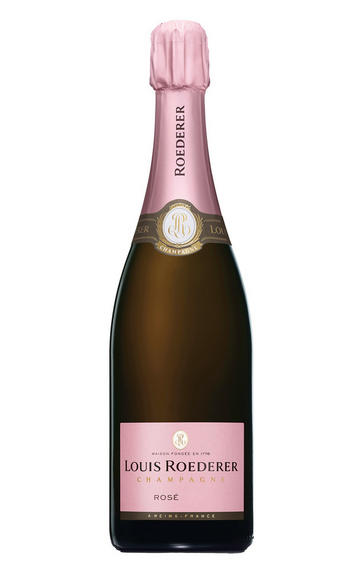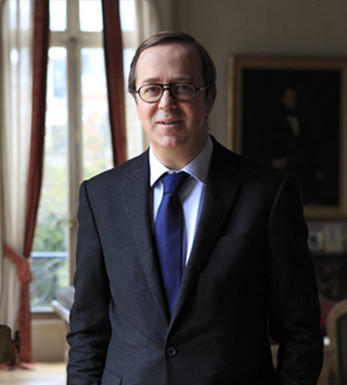
2014 Champagne Louis Roederer, Rosé, Brut

Critics reviews
The 2014 Rosé is soft, gracious and in inviting, all in a delicate style that can be enjoyed with minimal cellaring. Orange peel, spice, mint, star anise, rose petal, and dried flowers give the 2014 a decidedly exotic feel. Airy and perfumed, with lovely understated persistence, the 2014 is a very pretty wine. I would prefer to drink it on the young side. Like all of the Roederer Rosés. The vintage Rosé is a blend of Chardonnay (in this case from Chouilly) and an infusion of still red Pinot (from Cumières) that was given 7-10 days of cold soak. Dosage is 8 grams per liter.
Drink 2019 - 2026
Antonio Galloni, Vinous.com (December 2019)
63% Pinot Noir, 37% Chardonnay. Pale, onion-skin pink. Beautifully creamy, dairy nose with very savoury fruit and lots of rich, concentrated autolytic character on the finish. Smooth, mature, powerful – and drier than you might expect for rosé (only 8 g/l dosage). Demure.
Drink 2020 - 2024
Richard Hemming MW, JancisRobinson.com (February 2021)
Wafting from the glass with notes of pear, raspberries and honeycomb, mingled with hints of white flowers and brioche, Roederer's 2014 Brut Vintage Rosé is medium to full-bodied, deep and complete, with fine concentration, brisk acids and an elegant pinpoint mousse. Long and penetrating, this is a fabulous cuvée that punches well above its weight and comes warmly recommended.
Drink 2020 - 2040
William Kelley, Wine Advocate (March 2021)
About this WINE

Louis Roederer
Founded in 1776, Louis Roederer is a family-owned, independent Champagne house with a well-deserved reputation for quality. It is managed by Frédéric Rouzaud, the seventh generation to be at the helm.
In 1876, Louis Roederer created the now-famous Cristal at the request of Alexander II. This once intensely sweet wine is now one of the most luscious, deeply flavoured champagnes available, with the '88, '89 and '90 among the greatest Cristals ever released.
Louis Roederer’s best-selling non-vintage blend for almost 40 years, Brut Premier, has recently been replaced by Collection 242. This new multi-vintage blend was created by Chef du Caves Jean-Baptiste Lécaillon in response to increasingly warm vintages. The cuvée aims to capture freshness and is based on a perpetual reserve which focuses on acidity and minerality.

Rosé Champagne
Rosé wines are produced by leaving the juice of red grapes to macerate on their skins for a brief time to extract pigments (natural colourings). However, Rosé Champagne is notable in that it is produced by the addition of a small percentage of red wine – usually Pinot Noir from the village of Bouzy – during blending.
Recommended Producers : Billecart Salmon (Elizabeth Salmon Rose), Ruinart

Champagne blend
Which grapes are included in the blend, and their proportion, is one of the key factors determining the style of most Champagnes. Three grapes are used - Pinot Noir, Chardonnay and Pinot Meunier.
26% of vineyards in Champagne are planted with Chardonnay and it performs best on the Côtes des Blancs and on the chalk slopes south of Epernay. It is relatively simple to grow, although it buds early and thus is susceptible to spring frosts. It produces lighter, fresher wines than those from Burgundy and gives finesse, fruit and elegance to the final blend. It is the sole grape in Blancs de Blancs, which are some of the richest long-lived Champagnes produced.
Pinot Noir accounts for nearly 40% of the plantings in Champagne and lies at the heart of most blends - it gives Champagne its body, structure, strength and grip. It is planted across Champagne and particularly so in the southern Aube district.
The final component is Pinot Meunier and this constitutes nearly 35% of the plantings. Its durability and resistance to spring frosts make the Marne Valley, a notorious frost pocket, its natural home. It ripens well in poor years and produces a soft, fruity style of wine that is ideal for blending with the more assertive flavours of Pinot Noir. Producers allege that Pinot Meunier lacks ageing potential, but this does not deter Krug from including around 15% of it in their final blends.


Buying options
Add to wishlist
Description
Wafting from the glass with notes of pear, raspberries and honeycomb, mingled with hints of white flowers and brioche, Roederer's 2014 Brut Vintage Rosé is medium to full-bodied, deep and complete, with fine concentration, brisk acids and an elegant pinpoint mousse. Long and penetrating, this is a fabulous cuvée that punches well above its weight and comes warmly recommended.
Drink 2020 - 2040
William Kelley, Wine Advocate (March 2021)
wine at a glance
Delivery and quality guarantee